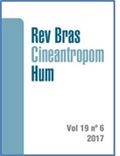The peak velocity of Carminatti’s Test for aerobic-fitness training in male soccer players
DOI:
https://doi.org/10.1590/1980-0037.2017v19n6p652Resumen
Aerobic energy transference is highly required and accounts for more than 90% of total energy consumption during a soccer match. In addition high aerobic fitness contributes to recovery from high-intensity intermittent exercise, specific to performance in soccer. The aim of the present study was to examine whether the peak velocity in the Carminatti’s test (PVT-CAR) for prescribing interval-training drills is effective in eliciting aerobic-fitness development intensities in male soccer-players. Fifteen Brazilian male elite soccer-players (U20) were tested for T-CAR and monitored for heart rate (HR) during PVT-CAR prescribed interval-training drills (i.e., 4x4min with 3min passive recovery). Drills were performed with a 1:1 work-to-rest ratio with either straight-line (6/6s) or 180° shuttle running (12/12s). The interval training performed at PVT-CAR elicited HR above 90% of HRmax and lactate above 4m.mol.l-1. In the shuttle-running drills, HR and lactate (93.3±2.1% HRmax; 7.7±1.4 m.mol.l-1) were significantly higher than in the straight line drills (vs 90.3±2.6 %HRmax; 4.5±0.9 m.mol.l-1). The coefficient of variations showed low inter-subject variability in HR (CV 2.3 and 3.0% for 12/12 and 6/6 respectively). The results of this study demonstrated that PVT-CAR can be successfully used to individualize high-intensity interval running training in players with different aerobic profiles, while shuttle-running drills presented higher values at intern load than straight line. The physiological and time-motion profiles resemble the most demanding phases of the match, especially for the fittest players.
Descargas
Publicado
Número
Sección
Licencia

Direitos Autorais para artigos publicados nesta revista são do autor, com direitos de primeira publicação para a revista. Em virtude da aparecerem nesta revista de acesso público, os artigos são de uso gratuito, com atribuições próprias, em aplicações educacionais e não-comerciais, desde que seja dada a atribuição. Esta obra foi licenciada com uma Licença Creative Commons Atribuição 4.0 Internacional - CC BY


